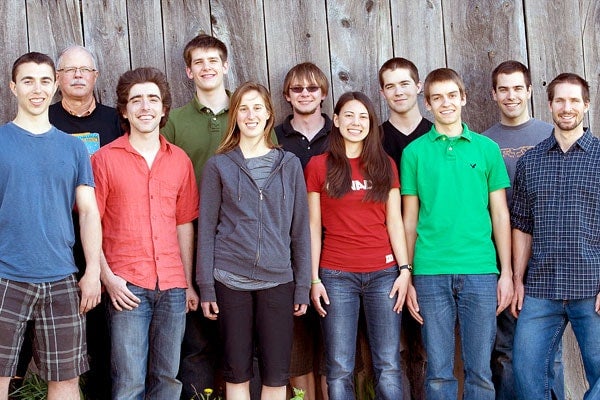
The quest to build a human-powered helicopter
Published: May 29, 2012
They gave the world the first human-powered “ornithopter” for bird-like flight. Now, a University of Toronto-based design team has a new goal: a human-powered helicopter.
The team, led by U of T alumni Todd Reichert (EngSci 0T5, UTIAS PhD 1T1) and Cameron Robertson (EngSci 0T8, UTIAS MASc 0T9), is seeking to build a human-powered helicopter and winning the Igor I. Sikorsky Human-Powered Helicopter Competition.
“An attempt at the Sikorsky Prize was the next obvious step for our team,” said Robertson. “The helicopter is where many of our contemporaries in human-powered flight are focusing, and it's becoming a very exciting and competitive atmosphere."
The American Helicopter Society International established the Sikorsky Prize in 1980. To win the $250,000 reward – the third largest monetary prize in aviation history – a human-powered helicopter must maintain flight duration of 60 seconds, reaching an altitude of three metres (9.8 ft) while remaining in a 10 metre (32.8 ft) square.
No one has ever been able to claim the prize.
The U of T team, known as AeroVelo, has good reason to believe they will be the first. Its core members have been working together since 2006, when they founded U of T’s Human-Powered Vehicle Design Team. In August 2010, the team’s first project – the construction of the world’s first successful human-powered ornithopter – made aviation history by achieving the age-old dream of human-powered bird-like flight.
Called Snowbird, the ornithopter sustained both altitude and airspeed for 19.3 seconds, and covered a distance of 145 metres at an average speed of 25.6 kilometres per hour.
The team is also responsible for U of T’s Human Powered Vehicle, which reached 117 km/h at the 2011 World Human-Powered Speed Challenge, held in Battle Mountain, Nevada. That represents the ninth fastest time ever achieved and less than 17 km/h behind the current world record.
Now the team’s attention has turned to a human-powered helicopter, named Atlas.
“We've been driven to push the limits of engineering further than ever before,” said Robertson.
The AeroVelo team assembled in Tottenham, Ontario, includes engineering students and professionals, many of whom are U of T graduates. They aim to have the helicopter built and flying by the end of August 2012.
To finance the project, the team has turned to an increasingly popular way to attract financial support: crowd funding. The notion is that a large number of people provide a relatively small contribution. In return, supporters receive perks and products. To be successful, a goal has to be reached before the deadline for the team to receive the funds committed by supporters.
AeroVelo is hoping to raise $30,000 by June 16 through KickStarter, a well-known crowd funding website. That is less than 18% of the total budget of $170,000. To contribute to the project, visit the team’s KickStarter page.
Reichert, who also flew the Snowbird, will fly the helicopter. With an output of 772 watts per minute, he will be the most powerful athlete to ever fly a human-powered helicopter.
“The Sikorsky Challenge provides an inspirational narrative,” Reichert said. “The project pushes the boundaries of possibility, showing that with creative solutions and innovative design we can do far more with far less.”
Watch the video here.



